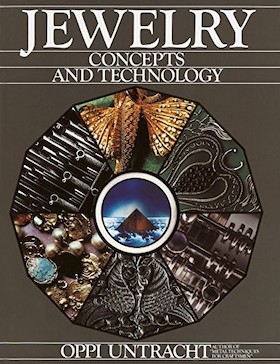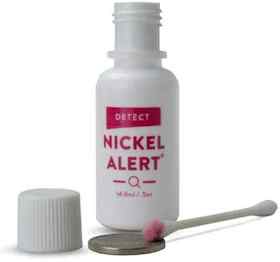
-----
Gold plating over sterling silver?
< Prev. page (You're on the last page of this topic)
Q. We are talking about electroforming gold over both silver and or wax. I would appreciate your input on what electroforming solution would be good to use.
vic masciarelli [returning]- Northborough, Massachusetts
May 30, 2016
Q. We would be using Technic gold electroforming solution.
Also I have a second question: why do electroplating and electroforming companies move the items either back and forth or back and forth in a circular pattern when they are plating ?
thanks
Vic
- Northborough, Massachusetts USA
June 14, 2016
A. Hi Vic. Technic offers every type of gold plating solution, but will have a technical data sheet which explains what type of plating solution it is, and offers estimates of the plating rate.
The parts are moved for "agitation" -- which is sometimes done mechanically as you describe, sometimes by pumping the solution towards the parts, sometimes by injecting air into the bottom of the tank and letting it bubble up towards the surface, or a combination.
Agitation keeps the solution uniform, so it's not starved of gold or other constituents near the parts, and to some degree it thins the "boundary layer", the quiescent layer of plating solution adhering to the surface of the part, which slows the plating rate as the ions fight their way through it. Good luck.
Regards,

Ted Mooney, P.E. RET
Striving to live Aloha
finishing.com - Pine Beach, New Jersey
Ted is available for instant help
or longer-term assistance.
Q. Hi
I am interested in why vintage or antique jewelry that has a silver base and then is finished with a vermeil gold coating maintains its finish unlike costume jewelry. The gold layer seems to remain intact with regular wear and therefore a great economical alternative to karat gold jewelry. You mention here that silver jewellery usually has another coat of perhaps nickel before gold would be applied. I do not know if jewellery created in the 1920s to 1940s would have this additional layer or not.
I thought maybe it would have something to do with gold and silver's placement in the periodic table, but have forgotten my chemistry! It is a group 11 as are silver and copper so I think there is something in that.
Kind regards,
Kate
- Kent, United Kingdom
May 11, 2017
A. Hi Catherine. While it is considered a good idea to have an anti-diffusion layer of nickel or other material between silver and gold, I don't that is not really the main issue here. Rather, the Vermeil jewelry probably had a gold plating thickness of 2.5 microns. Moderately good sterling silver costume jewelry from the '50s and '60s might have had "micron plating", about 1.0 micron of gold plating. Cheap costume jewelry today probably has a gold plating thickness of less than 0.25 micron -- I've seen some vendors call 0.0000065", <0.17 microns, "heavy gold plating" :-)
Simply put, the gold plating on Vermeil jewelry was at least 10X as thick as the plating on cheap costume jewelry of today, maybe 16X as thick.
Regards,

Ted Mooney, P.E. RET
Striving to live Aloha
finishing.com - Pine Beach, New Jersey
Ted is available for instant help
or longer-term assistance.
Q. My ring is too small but it is Sterling silver with a gold plating what can I do?
Kristina Brooks- Aurora Colorado
June 29, 2017
A. Hi Kristina. The simplest answer is that silver rings can generally be stretched. Please visit a jeweler and talk to them about it.
Regards,

Ted Mooney, P.E. RET
Striving to live Aloha
finishing.com - Pine Beach, New Jersey
Ted is available for instant help
or longer-term assistance.
Q. Hello and thank you for sharing your expertise. For my business I have a need to gold plate about 100 sterling silver charms (like the kind used on charm bracelets). They are small, around 10 mm-12 mm each, but do vary in size. Do you think I can find someone who can do this at a reasonable price? It is also very important that the gold last for 5 years +, or be permanent. Also, would it be possible for a professional to "dip" the charms in gold? Paint on gold leaf?! Not sure what is the best course of action. Thanks very much for your thoughts.
Kathy Bertone- Naples, Florida, US
July 29, 2017
Ed. note: This RFQ is outdated, but technical replies are welcome, and readers are encouraged to post their own RFQs. But no public commercial suggestions please ( huh? why?).
A. Hi Kathy. Paint or gold leaf will not work. PVD processes will probably not be available to you because of the low volume. Electroplating with gold will be the technology to use, and the gold must be thick enough and/or have a protective clearcoat on it for good wear resistance. I'd try to find a gold plating shop and get a good thick coating of gold, at least one micron, maybe even 2-1/2 then clearcoat it (automotive clearcoat or UV-cured finger nail lacquer.
Regards,

Ted Mooney, P.E. RET
Striving to live Aloha
finishing.com - Pine Beach, New Jersey
Ted is available for instant help
or longer-term assistance.
ACRONYMS:
PMC = Precious Metal Clay
Q. My hobby is making silver jewelry. I use PMC, fine silver and sterling silver; and frequently I use all 3 in a single piece of jewelry. Lately I was try to apply a gold plate to a pair of earrings. The body of the earring is PMC3. In the center there is a circular cutout of 8 mms surrounded by a 10 mm round ss ^ sterling silver gallery wire bezel. I cleaned the earrings in an ultrasonic jewelry cleaner
⇦ on
eBay
or
Amazon [affil link] , then tried to electroplate using Midas 24 k gold plating solution. For some reason, I cannot fathom, the earring which is a about an inch and a quarter puffed diamond shape, is plating on the back and the edges, as well as the gallery bezel but the rest of the front in not plating. I tried it on the second earring of the pair with similar results. What is going on. Help, please, I would be so grateful.
Thanks,
- Baltimore, Maryland, USA
September 5, 2017
A. Hi Mariam. A picture is worth a thousand words; please e-mail to . Sorry, but I can't follow what you are talking about. But the gold plating is not going to adhere properly to the stainless steel anyway.
Regards,

Ted Mooney, P.E. RET
Striving to live Aloha
finishing.com - Pine Beach, New Jersey
Ted is available for instant help
or longer-term assistance.
A. You may have an incomplete firing of your metal clay and the binder or porosity is creating a film on the surface.
Neil BellAlbuquerque, New Mexico
![]() Thanks, Ted. I wasn't using stainless steel. When I said SS I meant sterling silver. Anyway, the problem is now solved; I tried electrocleaning the earrings and tried again and it worked! I must have got something on them that did not get cleaned off properly. So I'm happy for now, but I really appreciated your response and also Neil's - thank you!
Thanks, Ted. I wasn't using stainless steel. When I said SS I meant sterling silver. Anyway, the problem is now solved; I tried electrocleaning the earrings and tried again and it worked! I must have got something on them that did not get cleaned off properly. So I'm happy for now, but I really appreciated your response and also Neil's - thank you!
Mariam
- Baltimore, Maryland
Q. Hello! My question is in regards to one of your answers where you stated that gold would not adhere to stainless steel? I was under the impression that there have been new developments in making that work. Can gold now be successfully applied to Stainless steel? And with all your wonderful Knowledge, I'm curious what you think About stainless steel used for jewelry? Thank You for sharing so much with so many!
Christine Doehring-HubbardArtist - Hitchcock, Texas United States of America
November 7, 2017
A. Hi Christine. I know very little about jewelry fabrication, so I can't advise very well on what is workable in fabrication; and I have no taste in jewelry matters nor artistic ability, so I can't advise what would look good either :-)
But with regard to gold plating onto stainless steel, the issue is not the gold plating per se, but the stainless steel. Electroplating requires a good metallurgical bond onto clean non-oxidized metal, whereas stainless steel instantly forms a passive oxide film on itself whether in air or water, so the plating will not adhere properly.
The solution to the problem is usually what we call a "Wood's Nickel Strike". This is a strongly acidic mixture with only a little nickel in it; the acid attacks and dissolves the oxide skin on the stainless steel while the nickel simultaneously plates out onto it. Then, while the nickel plating is still fresh and non-oxidized, gold or whatever can be plated onto it. It is not impossible to formulate a very highly acidic "strike" solution using gold instead of nickel (it's sometimes done in electronics plating), but it is not what is normally done, and it would not be a decorative 'final' gold plating anyway -- you'd still need both a "strike" solution and a decorative plating solution. Good luck.
Regards,

Ted Mooney, P.E. RET
Striving to live Aloha
finishing.com - Pine Beach, New Jersey
Ted is available for instant help
or longer-term assistance.
A. The Stainless steel activator is indeed Nickel chloride in acid solution (HCl), that is what most people recommend but I wonder if using Cobalt Chloride strike instead would be best since 30% of people are allergic to Nickel. I've been searching and could not find any information about Cobalt strike as activator but I've been able to successfully strike Stainless steel with Cobalt in the past.
Marvin Sevilla- Managua, Nicaragua
Gold Plating on Silver Surfaces
Q. Hi everyone;
I am Irem from Turkey, Izmir. I was graduated from Chemistry of METU. My father is a jeweler. We have decided to work own job by plating gold on the silver surfaces. I have made many pieces of research on this topic but I could not find gold plating on the silver surfaces process which gives detail of it.
I would like to learn process steps of plating, required bath solution name, and concentration and required voltage or current amount.
Please someone can give the process detail or reference document for it?
Thanks in advance.

Irem Tuncel Boğaz
Chemical Coating Engineer - Izmir, Turkey
December 28, 2017
A. Somewhat old but very good book on that subject is Oppi Untracht's "Jewelry Concepts and Technology" (try amazon com or abebooks if you want used and cheaper book).
Erhard Brepohl's book Theory and Practice of Goldsmithing
[on
Amazon affil links] is very good too. There you can find first class infos on gold plating silver jewelry. Latest edition of Lowenheim's "Modern Electroplating"
[on
AbeBooks,
eBay, or
Amazon affil links]
can be usable too. Hope it helps and good luck!
- Cerovski vrh Croatia
Sterling pendant causes skin reaction
Q. Hi, what would be the best way of putting a gold finish on a sterling silver pendant. I made a Sterling silver pendant for my niece, but for some reason her skin seems to be reacting to the silver metal on her chest. She loves it and does not want to change it but she does wear a lot of gold so I had thought I may be able to melt some gold and dip the silver into it but after reading all of what questions have been asked I guess it is not a simple thing to do. Do you have any suggestions to be able to put a coating of some sort onto the Sterling silver pendant. Thank you
Barbara Olive- Queensland, Australia
October 3, 2018
A. Hi Barbara. It would be much easier to put a clear lacquer coating on it. Some are sold specifically for this purpose .
Regards,

Ted Mooney, P.E. RET
Striving to live Aloha
finishing.com - Pine Beach, New Jersey
Ted is available for instant help
or longer-term assistance.
Q. Thank you for your prompt info. I will find out if the company I buy my silver from if they add Nickel when producing it. I always thought copper was added to silver not nickel. I know all of their silver is recycled. I have been buying silver from them for quite a few years and have never had anyone react in any way from wearing it.
Thank you
Barbara
- Queensland, Australia
October 6, 2018
Q. My plater doesn't provide a white bronze undercoat on my sterling silver jewellery prior to the gold plating.
Apparently they don't have the facilities to do it.
The specifications are 2.5 to 3 microns of gold on sterling silver.
Is the white bronze step crucial to the longevity of the gold plate finish given that is will be 3 microns thick?
This is one reason as to why I am thinking of buying a home plating kit.
What are the pros and cons of doing a white bronze undercoat if I decide to do all of my plating at home?
- Melbourne , Victoria, Australia
October 10, 2018
A. Hi Kaye. Everyone has an opinion on this diffusion issue, but I think much of it is extrapolation from personal & anecdotal experience with thin coatings or from stuff they read. Diffusion is clearly an issue for thin coatings of gold on silver both because the coating is thin, and because thin coatings can have porosity or vacancies which provide diffusion channels which accelerate the diffusion far beyond calculated values. But I doubt that many people have actually ever plated anything close to 3 microns of gold and lived to see silver diffuse through it.
If your plater is actually providing 3 microns of gold plating I personally think you have no worries of the gold and silver diffusing in a lifetime, and I would not include an anti-diffusion layer.
Naturally though, if anyone actually has experience with room-temperature diffusion through such a thick layer of gold, I'd love to hear it.
Regards,

Ted Mooney, P.E. RET
Striving to live Aloha
finishing.com - Pine Beach, New Jersey
Ted is available for instant help
or longer-term assistance.
A. Ted is correct. It's been our experience that 2.5 microns gold over silver is thick enough to avoid issues with diffusion.
Neil BellAlbuquerque, New Mexico
RFQ: Does anyone know of an individual who could gold plate silver earrings?
I sent my daughter's earrings for repair of a broken clasp. They were yellow. When I picked them up, they were "silver". The jeweler had put them in a cleaning solution which removed the "yellow" layer.
We had assumed they were real gold.
Now, she would like to have them gold plated again?
Is it possible?
Buyer - Lyman, Maine, USA
December 12, 2018
Ed. note: This RFQ is outdated, but technical replies are welcome, and readers are encouraged to post their own RFQs. But no public commercial suggestions please ( huh? why?).
A. Hello Hassina, having the earrings and or clasp plated in gold would depend on the "silver" color metal below what was once gold.
It could be stainless steel which would limit the number of jewelry repair shops that are equipped to do it. There is an acid gold strike that can be plated directly on stainless, which is a very thin coating and usually plated again in a different gold bath for added thickness. If it is silver or white bronze, yes, it can be plated in gold. A good jewelry maker has the ability to plate it. I have seen many with either a pen plating setup or a very small plating bath. A plating shop would be too expensive and don't normally take on one or two small pieces. A good jewelry maker would be your best bet.
Electronics plating - Phoenix Arizona USA
Plating White Bronze onto .925 Sterling Silver
Q. I want to plate .925 with a White Bronze/Copper solution from a top U.K. company, in the 2:1 self mixed ratio as recommended. Can the .925 accept the White Bronze mixture directly? Or, should I copper plate first? Can the mixture be adjusted, so as to enhance the yellow/golden glow of the copper, and still retain its hypo allergenic and tarnish resistance?
John Moresky- Long Beach, New York, United States
March 31, 2019
A. Hello John, you didn't reveal what you are plating, or whether you have a plating shop or not. Anyway, to answer you question, white bronze can be plated on sterling. The ratio of copper can also be adjusted in the white bronze solution. The adjustment amount would be better answered by your solution supplier. The part / piece to be plated must be polished well, ultrasonic or electro cleaned, activated and rinsed between all steps in distilled or DI water. Obviously a pilot lab setup with a little experimenting for color adjustments would be the way to go, them adjusting your main plating solution.
Electronics plating - Winston-Salem, North Carolina USA
Q. Thank you Mark. I want to plate small .925 sterling silver pendant settings, and .925 rope chains (very simple necklace). Which leads me to another question. Is it possible to simply 'stain' sterling? Similarly to gun black or the other sulfur ⇦ on eBay or Amazon [affil link] type stain I read about. Also, I have a 5V/18A Electroplater, can I anodize sterling?
John moresky [returning]- Long Beach, New York, U.S.
April 3, 2019
A.
Hello again John, I'm sure there is a way to blacken silver but my experience with silver is limited to plating the metal for electronics, functional and decorative products. I am unaware of methods to stain or anodize silver. Perhaps some of the other responders may be able to help you.
Electronic Plating - Winston Salem, North Carolina USA
April 4, 2019
A. Liver of sulfur ⇦ on eBay or Amazon [affil link] can blacken silver easily, though I can't comment on how durable the finish is for anything that sees much wear.
Brendan McNamara- Rochester, New York, USA
April 5, 2019
Q. Our company designs silver jewelry with a high focus on quality and comfort. Since we also wanted to offer gold colored pieces, we took on a long journey to find a reliable plater here in China than can help us produce high quality, hypoallergenic vermeil jewelry.
About six months ago, we finally found a plater specialized in electronic components that does pure gold plating at our required thickness (at least 2.5 micron, that is 'vermeil'). The only issue we had that the jewelry was slightly dull when it came back in some cases, but nothing a little buffing couldn't solve.
Unfortunately, (and to our horror) a couple of days ago two customers contacted us because their jewelry has tarnished within days (see photos). It seems we are back at square one with our search. In our book, pure gold shouldn't tarnish and we are still not sure what has happened.
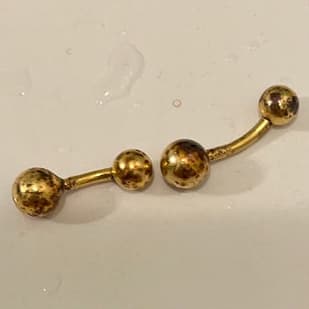
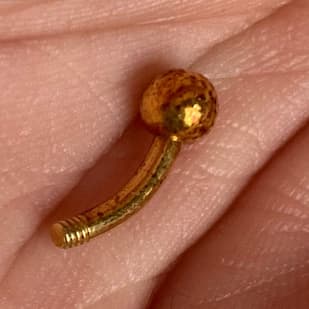
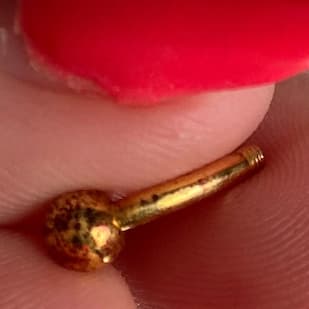
Our jewelry is made of sterling silver. After polishing and cleaning, we plate all pieces with an anti-tarnishing solution. We are not sure what this solution is entirely made of because of trade secrets, but it has served us extremely well in terms of preventing tarnishing and wearing comfort. We also tested it for any metals that are either dangerous, allergenic, or irritant, and nothing came up. After we apply the anti-tarnish, we send the items we want to have gold plated out to the plater. We are not entirely sure about this, but we think that our plater is using cyanide based solutions. If the jewelry looks dull after the plating, we lightly buff it with rouge, clean it in the ultrasonic and rinse with distilled water afterwards. Finally, all jewelry is sterilized in a hospital grade autoclave (steam under vacuum at 120 °C for around an hour, with a drying cycle at the end of it).
After confronting the plater with the corrosion problem our two clients have encountered, there has been a lot of discussions, but no clear explanation of what happened, nor a solution. So far, our guess is that:
1. On a few pieces we removed the anti-tarnish plating because we had to touch them up before sending them out to the plater, so with these pieces the plater applied the gold plate directly on sterling silver. So it might be the silver has migrated through the gold plating, but it is unlikely since the plating should be at least 2.5 micron thick.
2. The solution the plater used was contaminated or low in gold and therefore the plating was somehow defective (micro cracks, porosity etc) or had impurities which reacted with sweat, tap water, pool water or cosmetic products the customer was using. Or the plater made any other kind of mistake we can't think of.
3. We weren't careful enough when buffing the jewelry after the gold plate. We either physically damaged the plating, or residuals from the rouge or the solution of the supersonic bath we used are causing problems. The solution of the supersonic bath is 98% distilled water with a non-toxic, ammonia
⇦ on
eBay or
Amazon [affil link] -free, soapy cleaning agent.
We think in the future we will
1. avoid sending the plater any jewelry that doesn't have anti tarnish plating.
2. Polish the jewelry with any products after the plate.
3. Change plater. We already have sent samples out to one candidate. When they come back, we will send them to the lab to run three tests on them: thickness, safety (what metals the plating contains, something we do routinely to make sure there are no dangerous or irritating contaminants in the alloys) and a salt spray test (not sure yet for how long though). But since we are not really sure what went wrong with the current plater, we don't know if this will solve our problem for sure.
We are thinking also of:
1. Heat the jewelry at air to around 400 °C after the plating, or do short salt spray test to be able to single out any pieces that show signs of tarnish. We would need to buy an oven and/or a salt spray chamber to be able to run these tests on site.
To save your time, here is what we think won't work:
1. Applying an e-coat since we really don't know what it is made of, some types contain PVC, and some can be irritant. Besides, it shouldn't be necessary if the plating is done well because pure gold doesn't tarnish, right?
2. Use nickel plating as a base to increase adhesion because some people are allergic to it.
3. Use PVD or TiN because some of our jewelry contains gems that would be damaged in the process. Setting the stones after plating would be difficult for how our production process is set up.
So, in case any of you has another idea of what went wrong or has any suggestions on how to move on from here, we would be really glad. Also, in case someone can suggest a reliable partner with operations in China that does pure gold, or another kind of high quality gold vermeil plating, please let us know.
- Kunmin Yunnan, China
August 11, 2021
Ed. note: This RFQ is outdated, but technical replies are welcome, and readers are encouraged to post their own RFQs. But no public commercial suggestions please ( huh? why?).
A. Silver will migrate right thru gold, you must have a barrier layer like nickel or palladium.

Robert H Probert
Robert H Probert Technical Services
Garner, North Carolina

⇦ Tip: Readers want to learn from your situation;
so some readers skip abstract questions.
Q. Hi,
Would a 0.5 to 1 micron, 999 silver plated layer, act as a barrier layer instead of White bronze?
Thanks
- Kent, U.K.
February 13, 2022
A. Hi H. No, silver plating cannot serve as a diffusion barrier between silver and gold.
Please introduce yourself and your situation, but pending that my guess is that palladium will be the best barrier layer.
Luck & Regards,

Ted Mooney, P.E. RET
Striving to live Aloha
finishing.com - Pine Beach, New Jersey
Ted is available for instant help
or longer-term assistance.
Q, A, or Comment on THIS thread -or- Start a NEW Thread
